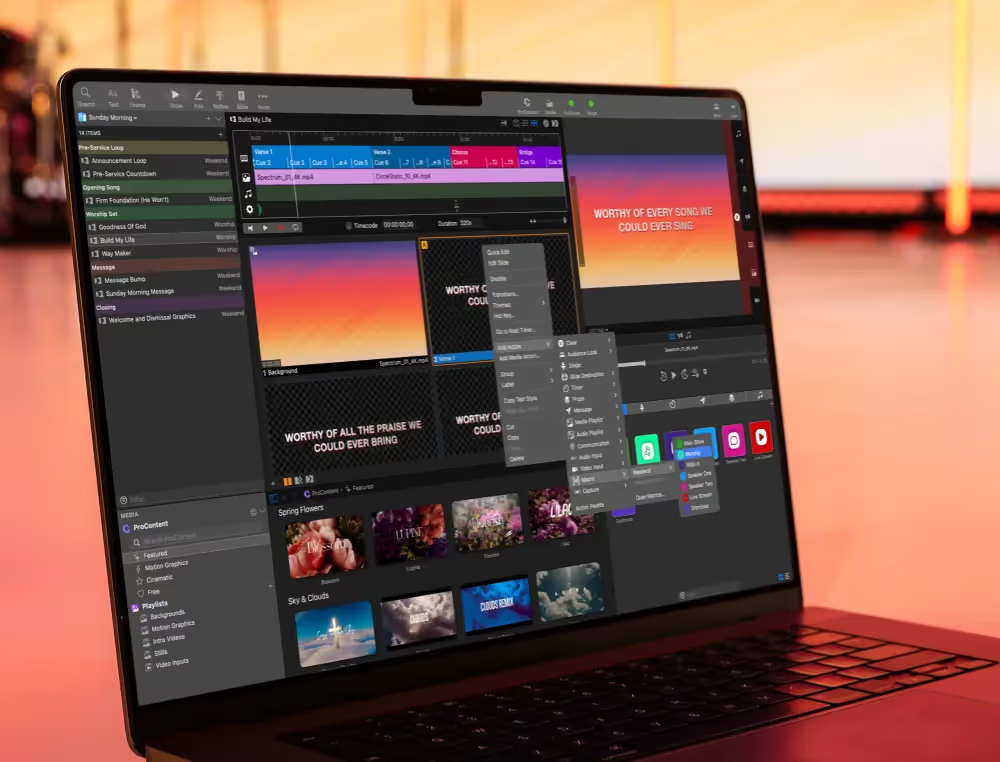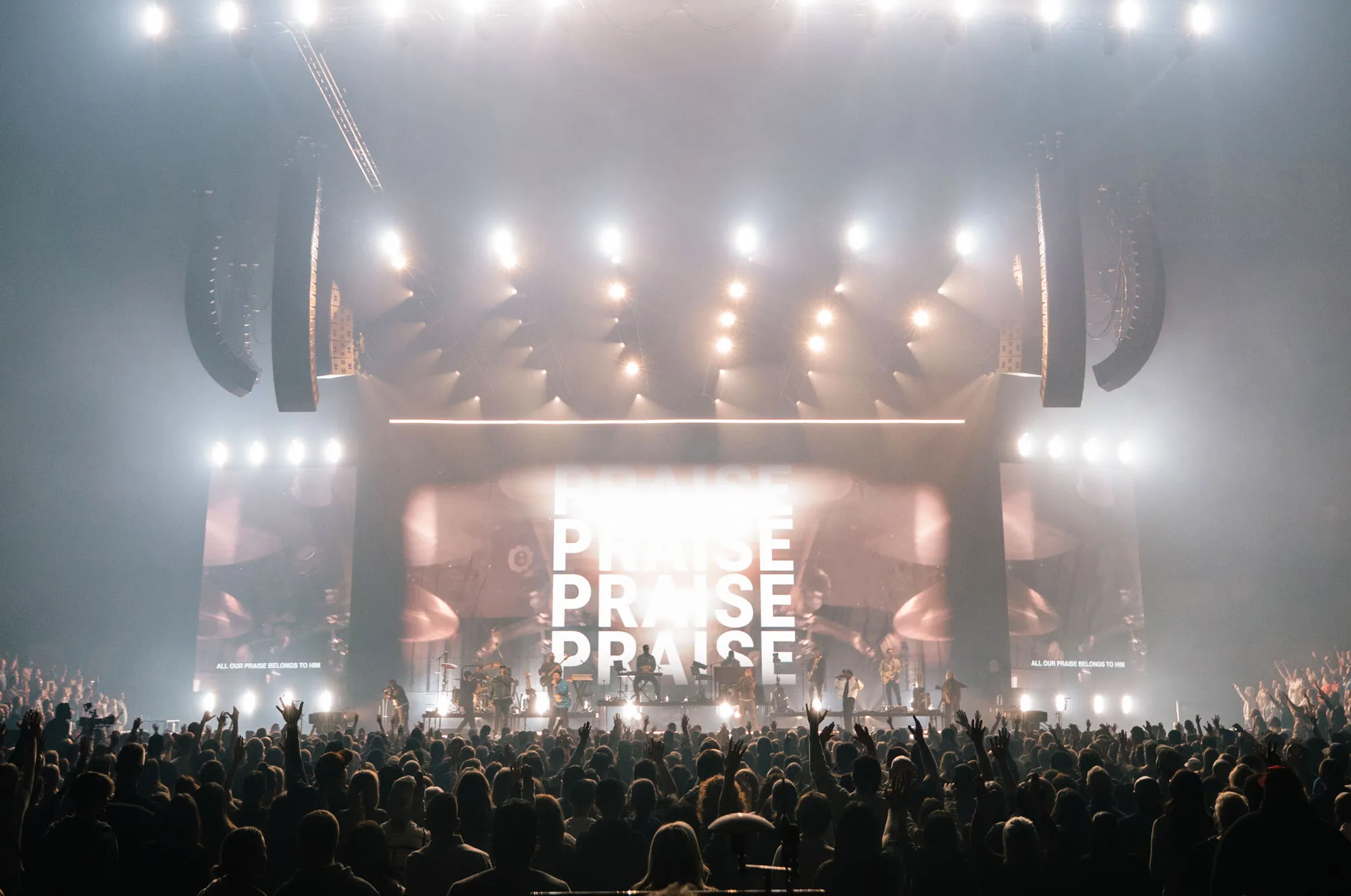Learn more Introducing the ProPresenter Lyric Banner!
What is 4K?
4K, or UHD, refers to a resolution (usually) of 3840 x 2160 and (again, usually) 60 frames per second. To put another way, 4K is four times the resolution of standard HD (which is 1920 x 1080), and is always progressive, rather than interlaced.
Should My Live Production be 4K?
4K is largely well-suited for broadcast or film productions because they usually have viewers either positioned closer to the screen or looking at a larger screen. The vast majority of event productions that we have worked on do not benefit from 4K resolutions because the distance of the viewer to the screens is such that the higher resolution difference isn’t discernible, and thus not worth the extra expense. If, however, you are looking to do other things with the archived video, or your live production makes use of an especially large screen, then you may choose to take the plunge.
The standard rules of video production equipment still apply as much as ever with the advent of 4K technologies:
- The quality of the lens on the front of the camera matters far more than the resolution of the image signal.
- Higher resolutions require faster processors in all of the equipment, which often comes at the cost of functionality. Functional requirements should usually take precedence over resolution for most productions.
- Smooth motion on video is far more important than the resolution of the image. Outputting smooth 4K video on a computer requires a much higher spec than that of HD.
- What you buy today will likely cost 20% less within 2 years.
If you’re debating between HD (720p60 or 1080i30), 3G (1080p60), or 12G (4K), a good rule of thumb is to look at the cost of the higher resolution standards compared to the HD equivalent. If you’re not budgeting at least double for 4K60, then the likelihood is that the equipment you are getting won’t show off 4K well.
Renewed Vision Products and 4K60
All Renewed Vision Products work with 4K broadcast standard hardware. Presently available SDI output devices include the DeckLink 8K Pro ($695), UltraStudio Extreme 4K, and UltraStudio 4K Mini. ProPresenterAlpha Keyer can make use of DeckLink 8K Pro or UltraStudio Extreme 4K to output two 12G SDI signals (key and fill). Each of these signals can be split (using either 2-sample interleave or square division quad) with a Blackmagic Teranex Mini 12G-SDI to Quad SDI converter.
Most Common Standards of 4K distribution methods in broadcast (using SDI)
Okay, we’re going to get technical here, but for good reason. As more and more screens are being utilized in live productions, the bandwidth of the data that powers those screens adds up. As such, it is important to understand what data rates are for each of the formats you may use in your live production so that you can make sure that the output methods you choose will work smoothly. While there are lots of frame rates and sizes used for various types of productions, most live video productions use one of the following:
1.5G (also called HD-SDI) – roughly 1.5 gigabits per second (gbps)
- 720p- 1280×720 at ~60 frames per second.
- 1080i – 1920×1080 at 30 frames per second (60 fields per second… a field is a fully interlaced frame of video, meaning every other line of the image… when two interlaced fields get combined, the result is a frame).
Do the math with either of these… let’s take 720p, for example. We are going to assume 8-bit video for this example, which means that there are 8bits for the green, red, and blue channels of each pixel… totaling 24-bits per pixel.
3G – roughly 3 gigabits per second (gbps)
- 1080p60 – 1920×1080 at 60 progressive frames per second (fairly obvious given it is double the 1080i signal).
6G – roughly 6gbps
- 4k30 – 1920×1080 at 30 progressive frames per second; this format was largely credited to Blackmagic Design as SDI cables did not support the higher bandwidth of 12G in the mid-2010s. While 6G became an SMPTE standard in 2015, Blackmagic Design began creating equipment for the standard in 2014 and remain the primary manufacturers of equipment and switchers used for this somewhat uncommon standard. It is a convenient standard because it uses just a single inexpensive SDI cable.
12G – roughly 12gbps
- 4k60 – 3840×2160 at 60 frames per second; this is easy to think about because a 4K signal is four times the size of a 1080p signal since it is traditionally, literally four separate 1080p60 feeds. Many 4K capable switchers won’t take a single 12G signal via SDI (which is fairly new to the industry and expensive), but rather will take four separate 1080p60 signals.
The Two types of 4K split signals
Since 12G SDI is somewhat nascent, manufactures of video switchers have commonly updated the firmware of their 3G production switchers to allow them to take 4K signals via four separate SDI lines. The two standards for this are:
- Square Division Quad Split: Quite literally, each signal contains a 1920×1080 quarter of the image.

- Two-Sample Interleave: The problem with the Square Division Quad method is that each signal is only a quarter of the full image. With two-sample interleave, the image is still broken out into four separate HD signals, but each signal is created by taking a series of 2-pixels from the larger, 4K image… thus resulting in each image being a full-frame HD signal of the larger 4K image. As such, taking the top 2 rows and 4 columns of the original 4K image would have the eight pixels split up like so:
AA BB
CC DD

What’s next?
In an upcoming segment, we’ll dive a bit deeper into the other two factors that determine the bandwidth of your video signals: Color Depth and Subsampling. Along with frame rates and resolution, these will help you determine just how many displays you can reliably power from a Thunderbolt 3 output of your computer.
By subscribing, you agree to our Terms and Conditions.
Experience the power of ProPresenter
Take your production to the next level with ProPresenter's intuitive suite of tools.

Stay Updated with Our Newsletter
Get the latest news, updates, and exclusive offers delivered straight to your inbox.

Questions?
Browse our FAQs or our Knowledge base that we’ve made to answer your questions. Need additional help? Connect with a support team agent!


.png)
.avif)